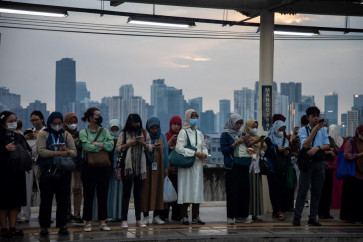Popular Reads
Top Results
Can't find what you're looking for?
View all search resultsPopular Reads
Top Results
Can't find what you're looking for?
View all search resultsSocial media plays role in youth smoking, says expert
The beauty of companionship: School children spend time in a convenience store in Pejaten, Pasar Minggu, South Jakarta
Change text size
Gift Premium Articles
to Anyone
T
span class="caption">The beauty of companionship: School children spend time in a convenience store in Pejaten, Pasar Minggu, South Jakarta. Some of the teens enjoy smoking while chatting. (thejakartapost.com/Elly Burhaini Faizal)
With the emergence of new digital technology, social media has become a marketing tool that cigarette companies aim to exploit. Targeting people on an individual level, social media allows organizations and companies to be much more specific and precise in accessing their audiences.
A sociologist from the University of Indonesia (UI), Roby Muhamad, said technology had enabled companies to enter the personal scope of consumers. Due to its characteristics, which are personal in nature, social media allows an increased affinity, closeness or familiarity between audiences and ideas or messages contained in advertisements, he went on.
'With social media, advertisements or any kind of persuasion will become more natural. A person can be persuaded without feeling that he or she has been persuaded,' Roby told thejakartapost.com in a recent interview.
Tobacco advertising is not yet prohibited in Indonesia, but it is limited by regulations. To prevent negative impacts of such advertising, the government has issued a regulation on tobacco control, which puts tougher restrictions on tobacco advertising in all forms of media. Digital media technology, or social media, has created new methods for marketing campaigns, however. Through social media, people may think they are doing something of their own choice, not because of outside pressure, including that from advertisements and other media.
'In fact, media is a system, which is intentionally built to convey corporate messages, in this example messages from cigarette companies. As social media is personal in nature, any decision based on information it conveys is much closer to emotions, not something rational,' said Roby.
As they target users' emotions, the sociologist added, advertisements and other media products on social media can create an emotional bond, which is deeper and more meaningful, so people feel their decision to consume or do something is part of their identity.
'In such a situation, if someone decides to consume something, it has nothing to do with the rational calculation of profit and loss. What happens in this situation is a social calculus, in which I do something not because this thing is beneficial to me or can inflict a loss for me, but more because other people like me will do this thing,' said Roby, a sociology lecturer with research expertise on social networking who is also involved in the Small Word Project together with Duncan J. Watts and Peter Sheridan Dodds.
Holy grail of marketing: University of Indonesia sociologist Roby Muhamad (pictured) says that with social media, companies can target consumers more specifically. (thejakartapost.com/Elly Burhaini Faizal)
The widespread exposure of cigarette advertisements has become one of the main concerns of the government in its efforts to prevent a growing pattern of youth smoking in the country. Citing the World Health Organization (WHO) Country Profile 2015, the National Commission on Tobacco Control said around 95 million people, or 38 percent of Indonesia's population, are smokers, with 20 percent of youth using tobacco. Youth now start smoking younger, the commission added.
Cigarette advertisements dressed up in various forms, from television advertisements, music and sports event sponsorships and marketing activities through to corporate social responsibility (CSR) events, have bombarded Indonesian youth. 'It was since the very beginning that the tobacco industry was really aware that tobacco advertising was an effective tool to ensure that the industry could continue to run its business,' said the commission.
Cigarette advertisements are deemed to have played a big role in the establishment of consumerism. Studies show innovative and entertaining commercials are dominating Indonesian television shows daily, blurring the lines between fantasy and reality.
'Many studies have proven that there is a significant relationship between influences that can be felt from cigarette advertisements and prosmoking information, and social environment exposure and smoking susceptibility,' said Aully Grashinta, a psychologist from the University of Pancasila.
With such huge exposure to ads, people may not be able to determine whether they consume a product because they really need it or just because they want to keep up their image. This is because commercials convey a set of ideas that structure the way people look at the world, influencing people's concept of reality.
'Teens must be aware that every person is prone to the tobacco industry's strategies so they must be equipped with skills to reject prosmoking advertisements,' she said.
Citing data from the Indonesian Advertising Agency Association (P3I), the National Commission on Tobacco Control revealed that the cigarette industry spent Rp 11.9 trillion (US$916,44 million) in 2012 to expose adolescents to advertisements focused specifically on young people, using the themes of adventure, lifestyle, bravery, life success, the beauty of companionship, friendship and more.
'It is proven that the cigarette industry has exploited children to become replacement smokers to ensure the continuity of its business, as has been written in their internal documents,' the commission added, referring to an RJ Reynolds Tobacco Company internal memo dated Feb. 29, 1984.
A communications expert from the University of Indonesia, Hendriyani, said the influence of advertising on society was very subliminal. It worked slowly but could adhere to each person, influencing him or her in making a decision. 'Advertising practitioners believe that advertisements will influence people's ideas,' she said in a public discussion held by the National Commission on Tobacco Control in Jakarta on March 2.
Citing advertising experts, Hendriyani said the creation of awareness was the first of four steps, along with the creation of interest, desire and actions that would influence people's decisionmaking.
'At first, people should be aware of the presence of an advertisement. If they aren't aware of it, how can it be processed further? To touch the public's awareness, an advertisement must be aired or published frequently and repeatedly. It must be created in various forms. This is how an advertisement can get into the awareness of the people,' Hendriyani said.
The most important thing to understand, she added, was that no cigarette company wanted to spend trillions of rupiah to advertise its products if it did not have any impacts on its business. 'It is impossible for a company to spend such a huge amount of money if economically, it is meaningless,' said the expert.
Hendriyani's statement corresponded with Nielsen Advertising Information Services data, which showed that in the second quarter of 2015, clove cigarette companies had the highest amount of advertising spending on TV, with a total spend of more than Rp 2.2 trillion (US$159.94 million), and recorded the highest ad spending growth, which reached 49 percent. Clove cigarettes ranked first among products with the highest ad spending value growth in the second quarter of 2015, which amounted to Rp 700 billion with three main contributors: Djarum Super Mild, Dji Sam Soe 234 and Sampoerna A Mild.
The rapidly growing social media world may change the advertising share for television and other mediums such as newspapers, magazines and radio as well as billboards. Although social media targets its audience specifically on an individual level, it can still carry out promotional activities on a large scale because of its low-cost digital character. 'Social media emerges like a holy grail for marketing. We can reach individuals in large numbers,' said Roby.
With the increasing use of the internet and social media to expose youth to tobacco, Roby said, Indonesia's antitobacco efforts must adapt to the new technology being used. 'It depends how good we are at using the new tools. We have to find new ways for antitobacco campaigns, which exploit the special characteristics of media that are currently most dominant,' the sociologist said.












